NASA's Moon rocket to 'ride out' potential hurricane Nicole

Even with Tropical Storm Nicole currently bearing down on Florida, and forecast to reach hurricane strength before landfall, NASA has decided not to roll its new Moon rocket back to safety. Instead, the rocket will have to "ride out" the storm as it passes, with the hope that it can still make next week's launch date.
NASA's Artemis 1 mission sits ready for its flight to the Moon! Having rolled out to Launch Pad 39B for an early arrival on Friday, Nov. 4, Orion spacecraft and Space Launch System are being prepped for a roughly 25-day trip in space.
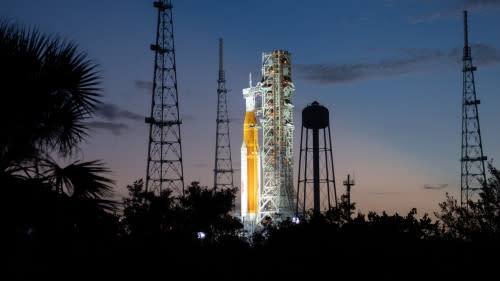
Orion and SLS sit at Launch Pad 39B, awaiting their next launch window, which opens at 12:07 a.m. EST, on Nov. 14, 2022. Credit: NASA/Joel Kowsky
Friday was the latest in a series of rollouts and rollbacks for the mission, as NASA was forced to send the rocket back to the Vehicle Assembly Building to address technical problems and to avoid damage due to the passing of Hurricane Ian.
Now, as they sit on the launch pad ahead of their Monday launch date, Orion and the Space Launch System face a new weather threat.
Tropical Storm Nicole is currently approaching the Florida coastline.
As of Wednesday morning, the US National Hurricane Center forecast says that the storm is packing sustained winds of up to 112 km/h. It is expected to reach Hurricane 1 strength, with wind speeds of 120 km/h, by Wednesday evening. The storm's track has it making landfall just to the south of the Space Coast, early Thursday morning. Its interaction with land should cause it to weaken back to Tropical Storm strength at that time.
Much of Florida's Atlantic coast, including Cape Canaveral and Kennedy Space Center, is now under a hurricane warning.
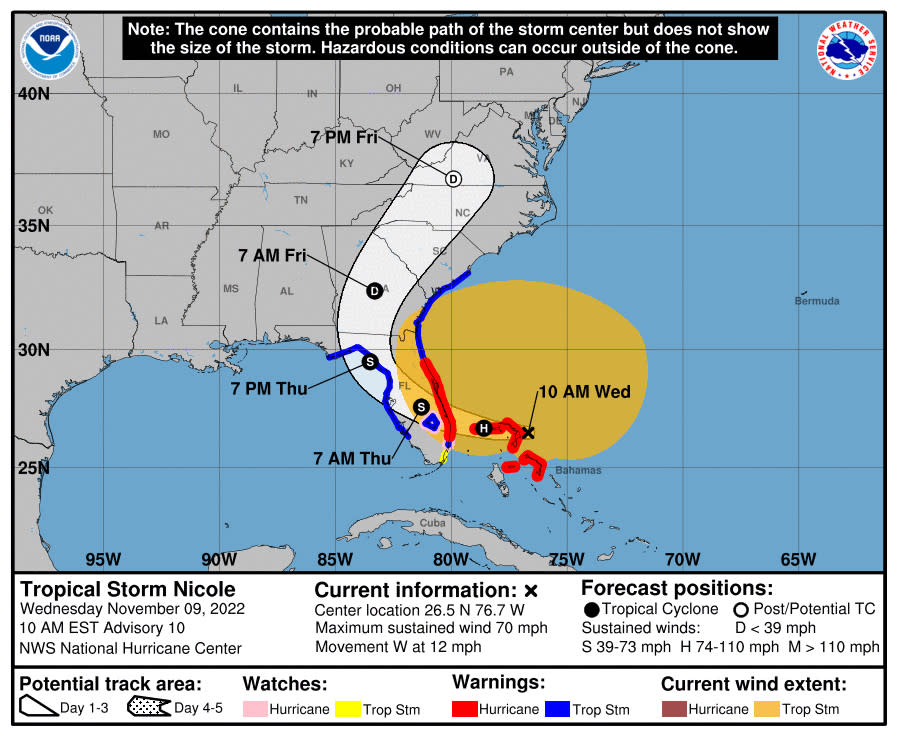
The 5-day track of Tropical Storm Nicole, as of Wednesday, Nov. 9. Credit: National Hurricane Center
Based on the forecast at the time, NASA issued a statement on Monday saying that "managers have determined the Space Launch System rocket and Orion will remain at Launch Pad 39B."
This decision was made due to the fact that it takes several hours to roll a rocket back to the safety of the Vehicle Assembly Building. During a rollback, if the rocket was exposed to winds exceeding 74 km/h, it could tip over.
However, in a Tuesday update, NASA said that Orion and the Space Launch System is designed to withstand winds of up to 138 km/h on the launch pad.

The Vehicle Assembly Building at Kennedy Space Center is not only where rockets are assembled for launch, but also where they can take shelter from approaching tropical cyclones. Credit: NASA/Bill White
By Tuesday evening, Kennedy Space Center was set to HURCON III (Hurricane Condition 3) status, which means that they were 48 hours out from experiencing 50-knot (92 km/h) sustained winds. NASA was securing all facilities and equipment at KSC, and deploying a "ride out team" of personnel that will remain at a secure on-site location to monitor the launch facility during the storm. The facility will upgrade to HURCON II and then HURCON I as the storm draws closer.
The US Space Force 45th Weather Squadron weekly planning forecast for Cape Canaveral and Kennedy Space Center is calling for rain at Kennedy Space Center for Thursday and Friday, with the potential for lightning and damaging winds Wednesday night through Thursday night. Wind speeds overnight from Wednesday to Thursday are expected to reach up to 74 km/h (40 knots), with gusts up to 101 km/h (55 knots), which is well below what Artemis 1 can endure.
If Tropical Storm Nicole had taken another path, with no impacts on Kennedy Space Center, Artemis 1 would have been set to launch just after midnight on Monday, November 14.
Once the storm has passed, if Orion, SLS and Launch Pad 39B come through unscathed, NASA expects to have the mission on track for a launch at 1:04 a.m. EST on Wednesday, November 16. In the case that they need more time, a backup launch date has been set for Saturday, November 19.
What is Artemis 1?
Artemis 1 is an uncrewed mission, controlled from the ground, during its 25-day flight around the Moon and back.

Artemis 1's flight path is detailed in this infographic. Credit: NASA
The Orion spacecraft won't be completely empty, though.
The three seats in the capsule will be occupied by specially designed mannequins. One, named Commander Moonikin Campos, is outfitted with sensors to test the stresses that astronauts will endure on future flights. Meanwhile, two mannequin torsos, or phantoms, named Helga and Zohar, will return data on radiation exposure during the trip.
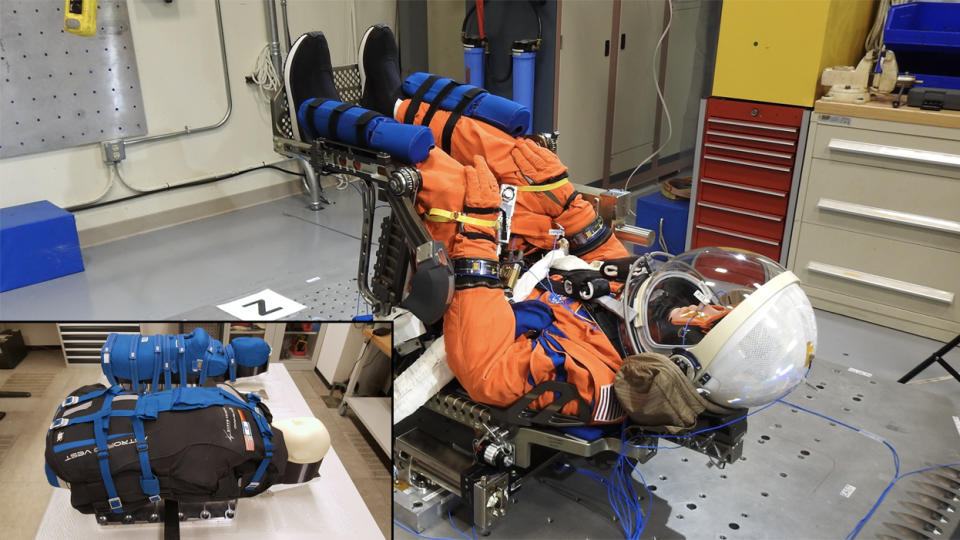
Test flight mannequin Commander Moonikin Campos sits in its flight suit ahead of the Artemis 1 flight. Inset, bottom right: the identical 'phantom' torsos, Helga and Zohar, will be fitted with more than 5,600 passive sensors and 34 active radiation detectors to measure radiation exposure as part of the MATROSHKA AstroRad Radiation Experiment (MARE). Credit: NASA
According to NASA, "Each of these purposeful passengers aboard Orion inform astronaut working conditions and safety, helping NASA and its partners better prepare for — and minimize — the potentially harmful effects from deep space missions for space travel farther from Earth, and longer in duration, than ever before."
These mannequins won't be entirely alone for this first return flight to the Moon.
Riding along with them will be a small plush doll of Shaun the Sheep (of Wallace & Gromit fame) provided by the European Space Agency.
"As one of the first astronauts to fly an Artemis mission, Shaun is leading the way in lunar exploration, a great honour for our woolly adventurer!" Lucy Wendover, Marketing Director at Aardman, the animation studio that created Wallace & Gromit and Shaun the Sheep, said in an ESA press release.

Shaun the Sheep, from the "Wallace & Gromit" claymation films and "Shaun the Sheep" TV series, poses in his ESA flight suit in front of a model of the Orion service module. Credit: ESA
Included in the collection of mementos going to space in the Artemis 1 Official Flight Kit are the rest of the Orion 'passenger' list — four LEGO minifigures, developed for LEGO Education's Build to Launch program, and a one-of-a-kind Snoopy plush that will act as the mission's zero-g indicator.
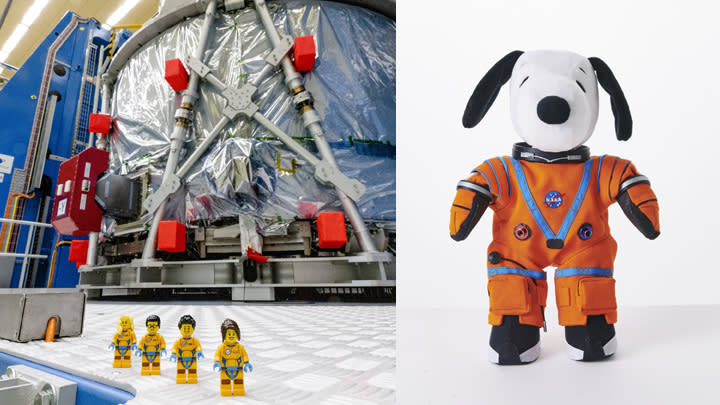
Left: four LEGO minifigures making the journey to the Moon with Artemis 1 stand in front of the Orion service module. Credit: NASA/Radislav Sinyak. Right: a unique Snoopy doll will act as the mission's zero-g indicator. Credit: 2021 Peanuts Worldwide LLC, provided by NASA
A Science Mission too!
NASA wouldn't send a mission to the Moon without including as many science payloads as they could fit on board.
In addition to the science instruments that will collect data on what the future crewed missions will experience on their flight, Orion will be carrying biology experiments and technology demonstrations.
One such demonstration, named Callisto, has a very 'Star Trek' feel to it.
Combining the technologies of Amazon's Alexa digital assistant with Cisco's Webex video conferencing system, Callisto will allow NASA controllers on the ground to retrieve information and issue orders to Orion using voice commands.
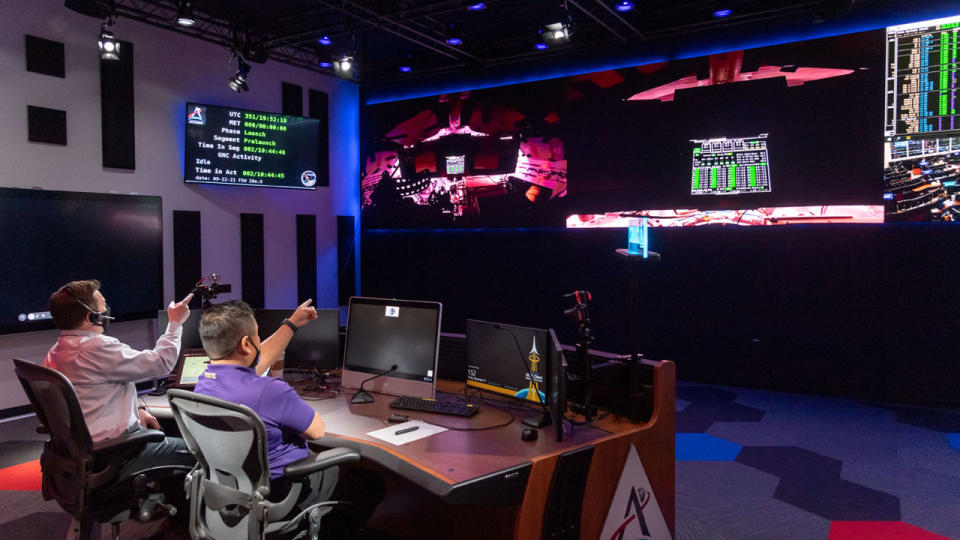
From this workstation at Mission Control in Houston, Howard Hu, the Orion deputy program manager, and Brian Jones, Lockheed Martin’s chief engineer for the Callisto project, observe signals from the Orion spacecraft at NASA's Kennedy Space Center in Florida during a test of the Callisto system. Credit: NASA
According to NASA: "Participants will assist with the demonstration by asking Alexa a question or delivering a task command in front of a console with a camera and microphone. Their images and voices will be broadcast from mission control to Orion, where video of the participants will be displayed on the tablet, and audio played from the speaker, and then Alexa will capture the audio and respond. Cameras inside the spacecraft will record the entire interaction and relay it through the network back to the room in mission control where participants can also see and hear the session."
If Callisto works, future space flights could be a bit more like flying on the starship Enterprise, as astronauts and their spacecraft share information simply by speaking to one another.
Riding to space along with Orion will be nearly a dozen cubesats, which will deploy on a variety of missions of their own, from investigating the Moon and the effects of space radiation, to demonstrating new space propulsion systems.
WATCH BELOW: NASA to send science experiments on the Artemis I mission to the Moon and back
NASA's Near-Earth Asteroid Scout (NEA Scout) will also be hitching a ride to space with Orion and SLS. After this tiny spacecraft separates from the rocket, it will shadow Orion until it reaches the Moon. At that point, it will head off on its own using a solar sail, which will use the Sun's light to propel the spacecraft towards its target — a near-Earth asteroid named 2020 GE.
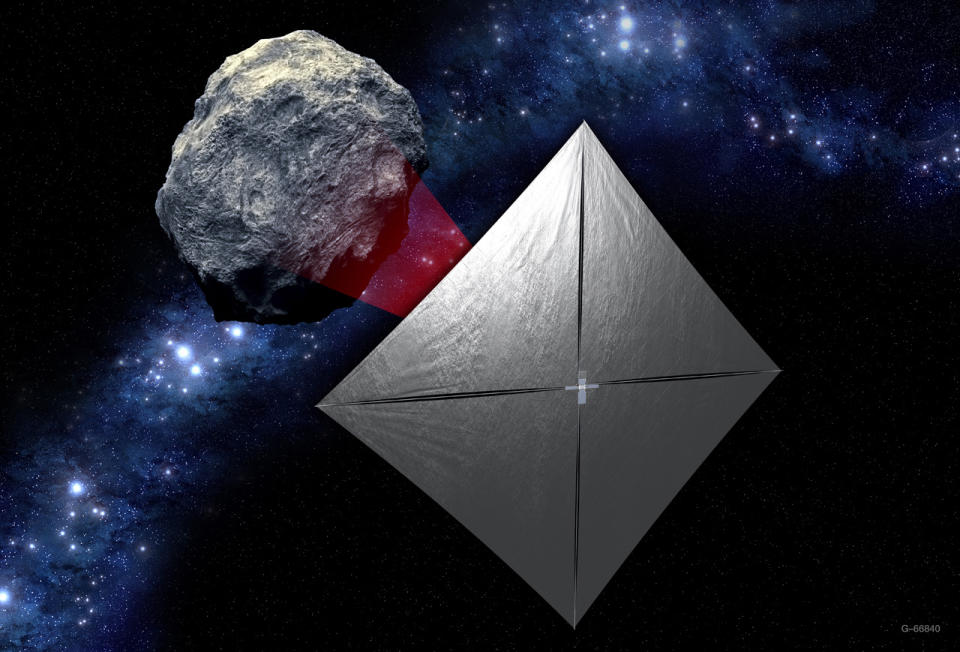
This artist's conception drawing shows NEA Scout investigating a near-Earth asteroid. Credit: NASA
According to NASA, NEA Scout will take about two years to fly roughly 150 million kilometres, or about the same distance as the Earth is from the Sun, to reach this asteroid.
"Once it reaches its destination, NEA Scout will capture a series of images of its target — ranging from 50 cm/pixels to 10 cm/pixels — which will be used by scientists on earth to better understand the object," NASA said.


